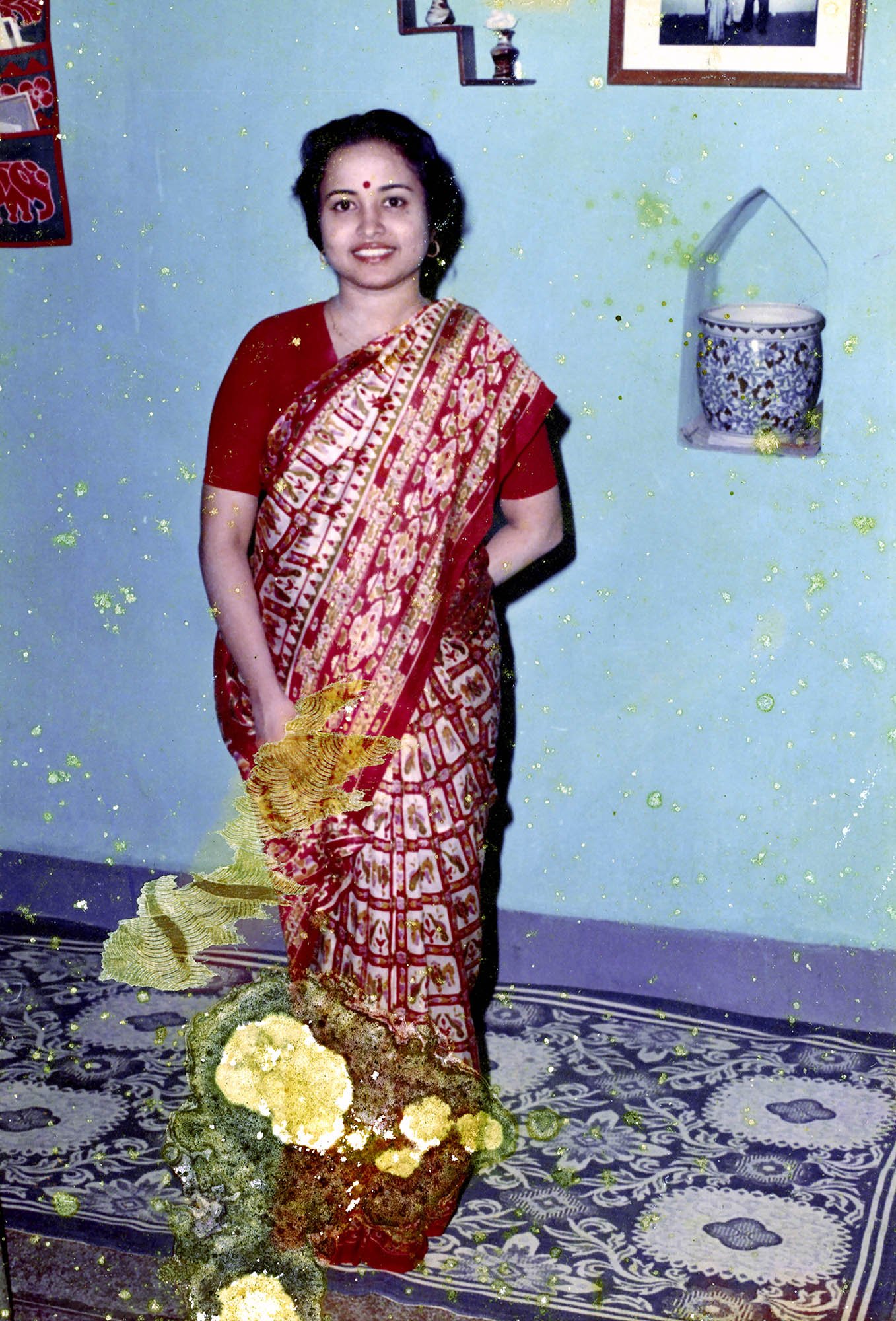Wanted Beautiful Home Loving Girl: Cheryl Mukherji’s Exploration of Family Albums, Matrimony & Desirability
For Cheryl Mukherji, a visual artist and writer who had once aspired to be a documentary photographer and came to Brooklyn, New York from Delhi, India with the hopes of becoming one - her shift to her work now did not come easy. It took a devastating robbery of her photography equipment just a semester before she was supposed to graduate, a whole lot of soul searching for what she cared about deeply and finding that it was her mother that was her muse and collaborator for her to reach where she is today. Having now exhibited at the National Portrait Gallery, Smithsonian (US), Baxter St at Camera Club of New York (US), amongst other exhibitions across Canada, UK and India - it might just have been a decision for the best.
Still Life (II), 2021
‘Wanted Beautiful Home Loving Girl’, her first solo show, is an exploration of photography, printmaking and sight-specific installations inspired by her mother’s matrimonial photographs that she brought with her to the US, safely preserved in her family albums. These photos of her mother, taken every year from the ages of 21 to 27 by (surprisingly) a medical school photographer, were sent out to potential suitors to arrange her marriage. “I really wanted to work on this project because one I started thinking of marriage because I didn’t want to go into another pandemic single and two because I was really interested in how these photographs acted as a visual currency that is exchanged between families. I started recreating them thinking of how I wanted to be presented as a bride and how women are presented in general,” she says about how the project came about from seeing these sub-archives. She goes on to say, “In fact, recently I realised that photographic conventions of women in India were for the voyeuristic purposes of British men in colonial times - the Victorian setting of backdrops in photo studios, the way women pose, how they’re made to look fairer or slimmer according to Euro-centric standards.”
I Want a Home, 2021
In her photos she maintains her subversiveness, fitting in and standing out of the exaggerated backdrops she has created, painting domestic spaces around her. “I feel like denouncing domesticity might work for some people but it is a very single toned view of feminism. For me personally, I felt empowered when I lived alone and cooked for myself. I wanted to reclaim that and not conform to other people’s ideas of femininity and rebelling,” Cheryl explains.
Bithika Roy Choudhary (Naani), Handpainted archival print, 2021
I ask her in the same vein why it was important for her to re-enter her family album, as she says, by creating this project so heavily inspired by archival images of her mother and grandmother - “I think of family albums as a manifesto that perpetuate this idea of how families should be, only celebrations and no depictions of actual family life. The men are seen as the heads of family, doing a gesture while women are portrayed as wives or daughters. It was important for me to re-enter the album but on my own terms and be the author of my own presentation.”
Playing Eve, 2021
For Cheryl, dating apps today and matrimonial photos work in a pretty similar fashion in the sense that they are both a kind of thirst trap and use superficial logistics, just with a different speed and lesser reach, to find someone for yourself.
Mukherji_Cheryl_12: Still Life (I), 2021
The reaction to her show differed with the audience demographic, South Asian aunties asking if this meant she never wanted to marry (the answer was “people can be two things at once, be subversive and want love”) and white friends asking her to sign up on an arranged marriage website for the kicks. “It's both white feminism and voyeurism. You can perform and exit but the stakes are very high for me. I'm still within the system and it's very hard to detach myself. I don’t just see arranged marriage from a distance.” In fact, she tells me, her mother is trying to set her up with doctors from New Jersey as we speak - a reality quite a few of us have been facing since we hit our mid 20s, with hit shows like Indian Matchmaking and The Bachelorette popularising finding love the arranged way. Unfortunately, this is also where a lot of Cheryl’s research lies - while we sit and laugh at the absurdity of these shows, she is lying in bed aggressively taking notes. She says she doesn’t have very strong opinions on the shows since she is still expanding on Wanted Beautiful Home Loving Girl, but we both agree that the women who had opinions on the show and were villainised were also our favourites.
Maa's Matrimonial Photo
We finally come to the subject that has been hounding me since I saw Cheryl’s work, her fascination with her mother. “I’m obsessed with my mother, I don’t even try to sugarcoat it,” she laughs. “A lot of my work is a communicative collaboration with my mother. Photography is usually talked about as a lone artist with a purpose but I believe there is room for people to work together. She sends me inspiration, we talk on the phone for hours, she's even on Pinterest looking for pictures. Obviously there was a conversation we had to have, because I was naked for a couple of photos, but she was very understanding after I explained why.”
Self Portrait with Maa (III), 2020
But in Indian culture where trauma, strife, just normal conflict do not walk out of the door, Cheryl’s projects make the viewer feel like they are almost intruding in her and her family’s private life. “I would be faking it if I said my parents were ok with this, my mother was very upset that I, in some ways, wrote over her beautiful memories, which I think is valid. But I too am allowed to look back at my life and have a different perspective on things. I don’t claim to be an expert but it is possible to resolve these issues through conversation. So much of my work is actually about myself through the lens of my mother in the archive and not in the present. I have more accountability because I'm working with a living archive, it's exciting to be working with that responsibility and with someone willing to communicate and understand.”
Her description of the deep friendship they share and how the both of them (although often having disagreements) have been able to re-learn each other as individuals despite not having seen each other in 4 years is heartwarming and makes one have hope that there is always space for communication, something that might be a takeaway from her art as well.
Dulhan Maachis, Silkscreen on matchboxes, 2021
She is currently at the Center for Photography at Woodstock for an artist residency, working more on expanding Wanted Beautiful Home Loving Girl, “I like to think of photography and how I can make more images a lot more than I do the act of photography currently. I’m thinking of how far I can push this project and where to draw boundaries. I want people to think about desirability and thirst traps as an activity everyone engages in to sell ourselves and our beauty.”
Cheryl also reveals that although her mother has played long-distance muse to her for many of her acclaimed works she is yet to photograph her, owing to her mother’s lack of willingness firstly and secondly, because they have been apart for 4 years owing to Visa issues. “I’m itching to go back home, not in a productive sense at all but just to be back home again. I’m just a little scared that so much of my mother and I’s relationship has changed that I don’t know whether I should go back to being the daughter I was before I left or the friend I am now.”
Classifieds Matrimonial, 2022
You can view Cheryl Mukherji’s other work at cherylmukherji.com
Installation, Wanted Beautiful Home Loving Girl, 2022









